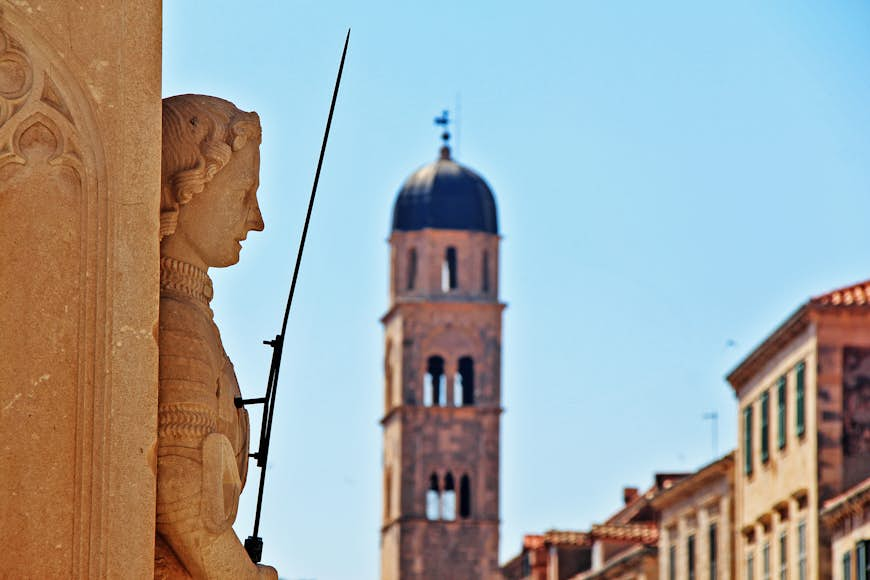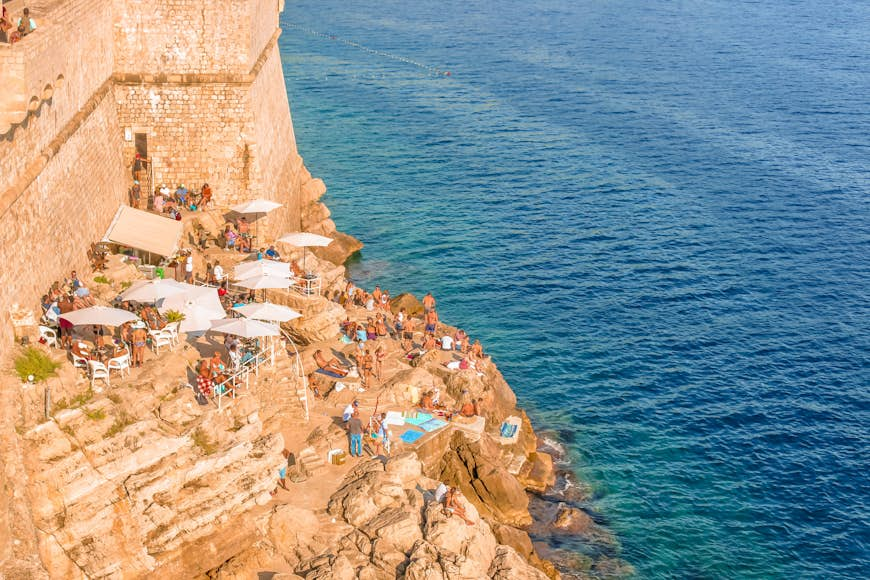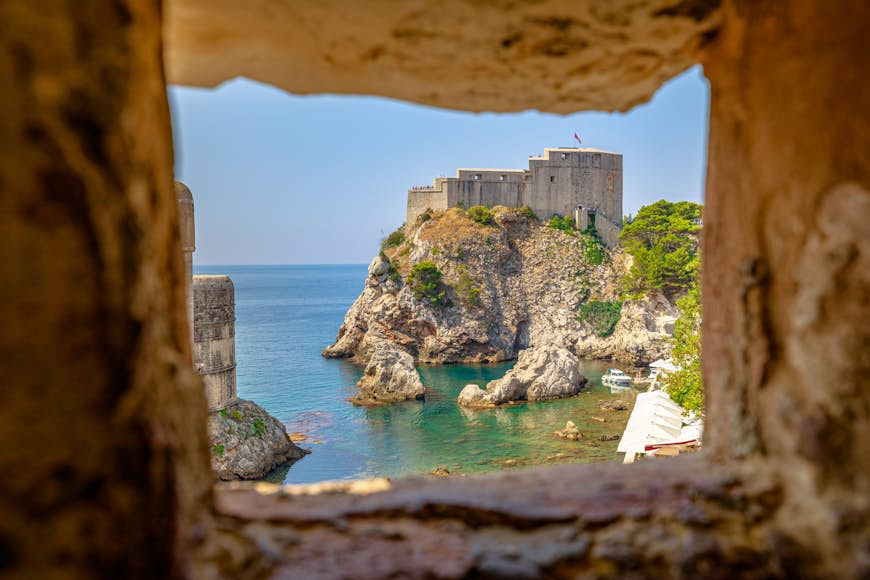Croatia has some stunning towns and cities, but none can match Dubrovnik for tourist appeal. The only problem? Given the number of visitors to this Dalmatian port’s small and lovely old town, budget travelers can feel squeezed out.
Never fear: while Dubrovnik can be expensive, some of the finest things to do in the city are completely free. Indeed, a lot of Dubrovnik’s appeal comes down to the experience of just being there.
Stone walls surround green-shuttered houses and elegant churches. During the day, the Adriatic sparkles with sunlight, while at night the paved streets – polished smooth by thousands of wandering feet – have a shimmer of their own. Check out great paintings and colorful markets, or take a swim off rocky coves – it needn’t cost you a Croatian kuna.
Get above the city on the Way of the Cross path and the Petka hills
Green hills dot the city’s outer rim, providing a lovely chance to enjoy nature without leaving Dubrovnik. For the best views, hike up the Way of the Cross path to the top of 413m-high (1355ft) Srđ hill to see the old town’s terracotta roofs spread beneath you like the palm of a hand.
Across town, the hiking trails on the Petka hills lead through the cool shade of Mediterranean forests up to stunning views of the tiny Grebeni rocks and the mystical Elafiti Islands. Timing is everything: avoid the high sun and come prepared with water, sunscreen, snacks and a sunhat.
Explore the real King’s Landing
Dubrovnik’s old town stood in for the great city of King’s Landing in the epic TV series Game of Thrones, providing the setting for intrigue, murder and some dagger-sharp one-liners – it looks likely to feature in prequel House of the Dragon too.
For a free self-guided walking tour of the highlights you could start at the Jesuit stairs (near St Ignatius church), where Cersei’s infamous “walk of shame” scene was set, heading past the Pile Gate (where a crowd threw manure at Joffrey). Stroll down to the shore (King’s Landing’s harbor), and continue west past Fort Lawrence (the Red Keep) to serene Gradac Park (where Joffrey had a bad wedding experience).
Wander the open-air museum of Dubrovnik’s old town
Dubrovnik’s old town is the city’s greatest sight. Its twin drawbridges and mix of medieval, Renaissance and Baroque architecture give it a fairy-tale feel, and as you explore it every square becomes a stage and every view a postcard. This was once the center of a trading network that stretched from the Adriatic to the Black Sea. Rebuilt after a 1667 earthquake, its promenades and palaces feel like they’ve barely changed in centuries.
The best part for budget travelers? While there’s a fee to climb the famous walls, the streets themselves are open to anyone. You can watch tourists and locals from the stairs of St Blaise’s Church, sit on a bench in the picturesque harbor, or gaze down at swimmers at Porporela.
Take in a Titian at the Cathedral of the Assumption
Churches in Dubrovnik display art by local artists and international greats. In the Baroque Cathedral, you can admire the Assumption of Mary, a three-paneled 16th-century masterpiece by Titian above the main altar. The church, like most in the city, is free, though there’s a small fee to enter the attached Treasury.
Other godly highlights include St Ignatius of Loyola Church, where stunning Baroque frescoes fill the main apse, and St Blaise’s Church, with colorful stained glass windows by renowned local painter Ivo Dulčić.

Discover what the ell’s going on with the Orlando Column
Many of the visitors who mill around cafe-packed Luža Sq don’t give the carved column in the middle a second glance. But this 1418 statue of an armored knight was once the city’s focal point. The Orlando Column shows the hero of the Song of Roland, a medieval poem that kicked off the whole idea of chivalry. Orlando was adopted by Dubrovnik as a heroic savior – and his 51.2cm (20.2in) right forearm became the city-state’s basic measurement of length, the “ell”.
Enjoy some free nibbles at Grad Market
The Grad Market adds a splash of vibrant color to the old town stone every morning. Many stalls stock such traditional local sweets as dried figs, arancini (Croatian candied orange peel), and bruštulani mjenduli (candied almonds), and offer a free taste before you buy. Foodies should also venture to the city’s main market in Gruž, which has its own fish market.
Remember the fallen at Sponza Palace
The 1991–92 war that followed the breakup of Yugoslavia left Dubrovnik shattered. Impressive repair work means the city’s scars are hard to spot, but if you look closely around the old town you’ll see damage from shrapnel and bullets, as well as plaques of remembrance. The ornate, 500-year-old Sponza Palace has a free Memorial Room that shows the portraits of the young men and women who died defending Dubrovnik during its seven-month siege.

Sunbathe on the beaches and rocks with the locals
The beaches are nearly impossible to privatize around Dubrovnik, so even the most popular ones, like Banje or Sveti Jakov, have room for beachgoers who prefer to put down a towel instead of renting a lounger. For sunbathing the way locals do it, head to rugged Danče or scenic Šulić; for adrenaline, dive off the rocks on Buža. For family time, venture across town to Lapad Bay, which offers pebbly shores and dramatic sunsets.
Fall in love with Adriatic coral at Clara Stones Jewellery
Visiting the exclusive Clara Stones Jewellery will teach you all about sumptuous red Adriatic coral. The region’s only semiprecious material is known for its shiny scarlet color – yet before craftspeople have their way with the material, it is neither shiny nor red. At the Clara Stones workshop, you can witness the magical transformation first-hand.
Volunteer on a water excursion with Green Sea Safari tours
It’s hard to believe you can take a day trip to the islands around Dubrovnik at no cost – yet with local NGO Green Sea Safari, you’ll pay for the experience in kind, by helping the group clean up remote bits of the coast. After about an hour’s work, it’s break time, as you swim in crystal-clear waters, island-hop, explore watery caves and more. While the NGO relies on donations, these aren’t obligatory.
Enjoy a free guided tour in the off-season
Each November and December (and sometimes through to March), the Dubrovnik Tourism Board throws in a freebie for the town’s low-season visitors. On Saturday mornings, free guided walking tours of the old town are followed by a folk singing and dancing performance on Luža Sq, providing insight into traditions that have nourished this gem of a city for centuries.
